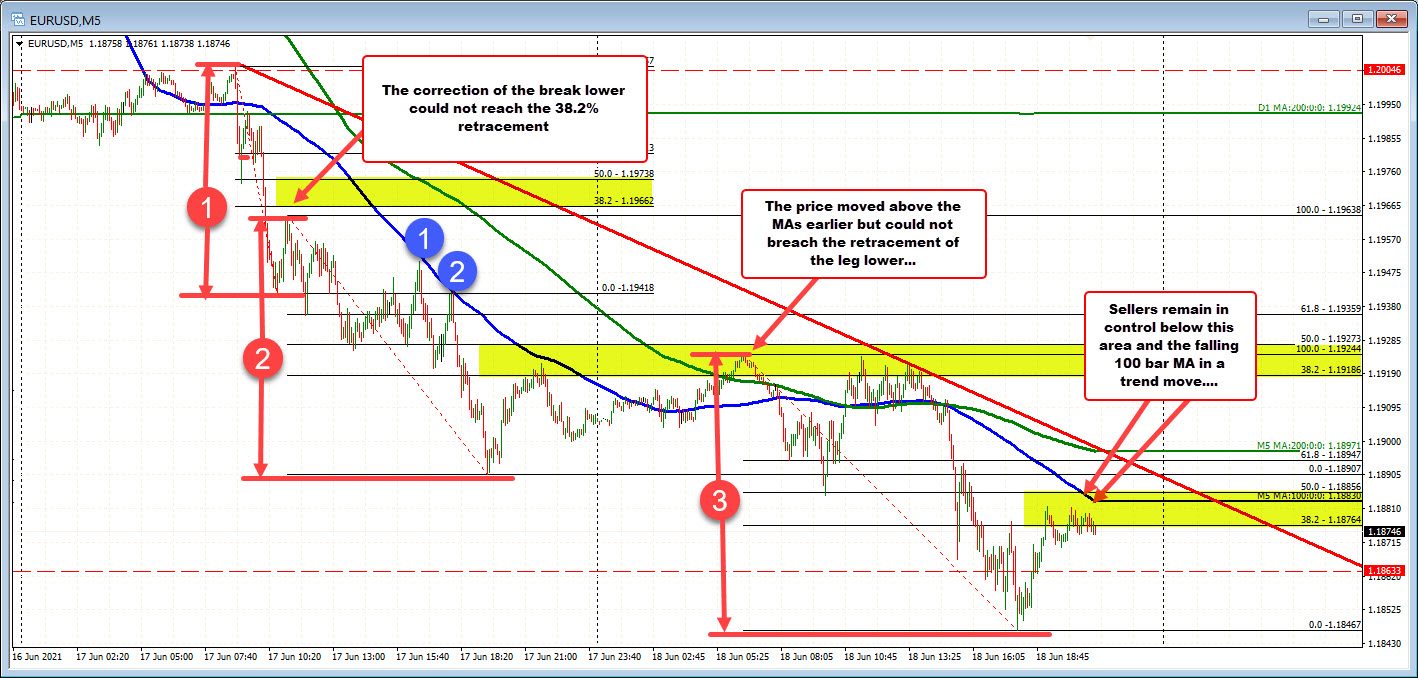Seller remain in control and this is why..
When the market trends, the 5- minute chart tells the trend story. Let me explain.
First, in what I feel might be a trend move, I focus on two things.
- The 100/200 bar MA on the 5-minute chart, and
- The 38.2-50% retracement of the trend legs lower (or up if an up trend).

Looking at the EURUSD 5 minute chart above, the pair yesterday consolidating into the Asian session (top left part of the chart), then made a run lower. Note the 100 bar MA was going sideways and then started to accelerate back to the downside. The 200 bar MA was not even in the picture when the first break occured (it was still catching up from the sharp run lower after the FOMC on Wednesday).
The first leg to the downside trended from 1.2005 to 1.1941 or about 60 pips. The 100 bar MA lagged behind. Putting a retracement on the 1st trend move (red number circle 1), the 38.2%-50% comes in at 1.1966 to 1.19738.
If the trend is not a trend (with momentum behind it), it makes sense that the price would not move above the 50% midpoint of the move lower, nor the 100 bar MA/200 bar MA. Moreover, traders who want to get on the trend will look to enter in that retracement area (i.e. they want to hop on the trend with the 50% as risk area).
The correction off that first trend move lower fell short of the 38.2% which shows that the sellers are more in control, and the sellers are more aggressive. The buyers meanwhile are NOT winning.
Sellers entered, exerted control, and started to push the pair lower in what was the 2nd leg lower (red number circle 2).
Note that the run lower for this leg is a little more drawn out, but as it is in progress, the 100 bar MA was tested twice (see blue circle 1 and 2).
It would make sense for a trend move to stay below the 100 bar MA if the trend is a strong one (i.e. if sellers are aggressive). It does just that at blue circle 1 and 2. The momentum to the downside starts to accelerate after blue circle 2.
The second leg lower goes from 1.1963 to 1.1890 or about 73 pips before rebounding.
This time the 38.2 to 50% of that leg lower is at 1.19186 to 1.19273. The price highs off that low stalls in the yellow retracement area. That is, the buyers COULD NOT get the price above the 50% midpoint of the last leg lower.
Are the buyers taking back control if they can't get above the 50% midpoint of the last leg lower? NO. Moreover, you can say, sellers are also hopping on the trend in that area (with risk on a move above the 50% somewhere).
Now what the the buyers were able to do was get above the 100 bar MA and the 200 bar MA. That does give traders some cause for pause that the price may correct more, and end the trend move lower. However, the top of the yellow area is not breached. The price stays below the 50% retracement.
After a move back below the converged 100/200 bar MAs, another run lower gathers momentum (trend move 3 - see red circle 3).
This move sees the price move from 1.1244 to 1.18467 (or 78 pips). A correction of that move can now be measured with another retracement of that trend leg.
This time the 38.2% and 50% is at 1.18764 to 1.1856. The 100 bar MA is catching up to that area and is at 1.1883.
Like the other trend legs, as long as the buyers cannot push above that yellow area and the 100 bar MA (and ultimately the 200 bar MA too), are the buyers taking control from the sellers?
NO. They can't even get above the closest of corrective targets. The sellers and the trend remains in tact.
SUMMARY:
When the market trends, it shows trend like characteristics. Trends tend to be fast, directional and go farther than traders expect. If that is the case, corrections are shallow and find sellers (or buyers if an uptrend) at levels that keep the pressure on the counter trend traders and exert an "alpha" over them.
It is no different than a boxer taking advantage of a hurt opponent, or a sport team keeping the pressure on an opponent they suddenly feel is fatigued or ready to quit.
Traders do the same thing in a trend. So look to be the aggressor and attack the trend until that time, when victory is declared and the buyers and sellers are evened out or the tide starts to turn in the favor of the counter trend.




